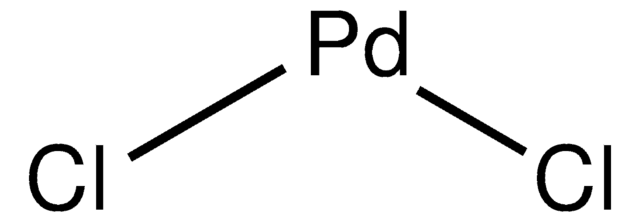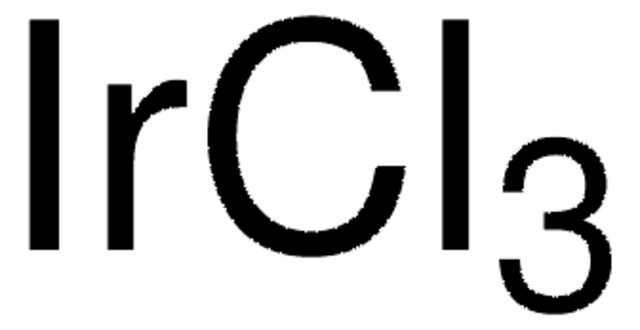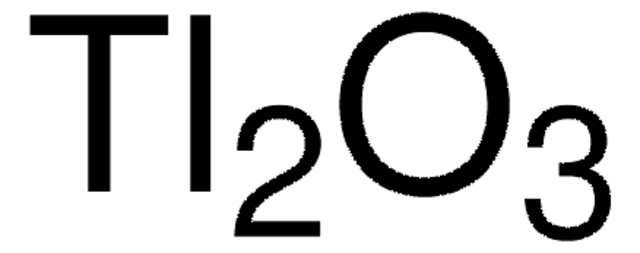All Photos(1)
About This Item
Linear Formula:
TlNO3
CAS Number:
Molecular Weight:
266.39
EC Number:
MDL number:
UNSPSC Code:
12352302
PubChem Substance ID:
NACRES:
NA.23
Recommended Products
Assay
99.999% trace metals basis
form
solid
reaction suitability
core: thallium
mp
206 °C (lit.)
SMILES string
[Tl+].[O-][N+]([O-])=O
InChI
1S/NO3.Tl/c2-1(3)4;/q-1;+1
InChI key
FYWSTUCDSVYLPV-UHFFFAOYSA-N
Looking for similar products? Visit Product Comparison Guide
Application
- Thallium(I) nitrate: Primarily used in the synthesis of other thallium compounds due to its reactivity and solubility. It finds applications in the production of special glasses where thallium improves the refractive index and density of the glass. Caution is advised in its use due to its high toxicity and potential environmental impact (Sigma-Aldrich, CAS 10102-45-1).
Signal Word
Danger
Hazard Statements
Precautionary Statements
Hazard Classifications
Acute Tox. 2 Inhalation - Acute Tox. 2 Oral - Aquatic Chronic 2 - Ox. Sol. 3 - STOT RE 2
Storage Class Code
5.1B - Oxidizing hazardous materials
WGK
WGK 3
Personal Protective Equipment
dust mask type N95 (US), Eyeshields, Gloves
Choose from one of the most recent versions:
Already Own This Product?
Find documentation for the products that you have recently purchased in the Document Library.
A Salinas-Castillo et al.
Analytical and bioanalytical chemistry, 376(7), 1111-1114 (2003-06-28)
The applicability of heavy atom-induced room-temperature phosphorescence to pharmaceutical samples is demonstrated in this work. Thus a new, simple, rapid, and selective phosphorimetric method for dipyridamole determination is proposed. The phosphorescence signals are a consequence of intermolecular protection when analytes
P Thanigaimalai et al.
Bioorganic & medicinal chemistry, 18(12), 4441-4445 (2010-05-18)
The oxidative cyclization of 2'-hydroxy-6'-cyclohexylmethoxychalcones 5 using thallium (III) nitrate (TTN) in alcoholic solvents produced isoflavones 2 and (or) aurones 3 depending on the electronic nature of p-substituents on ring B. Chalcones with strong electron donating substituents (OH, OCH(3)) were
Vânia M T Carneiro et al.
The Journal of organic chemistry, 75(9), 2877-2882 (2010-04-10)
A diastereoselective route to (+)-bakkenolide A is presented from the readily available optically active Wieland-Miescher ketone. This novel synthesis of this sesquiterpene lactone features the following as key stereoselective transformations: (i) the ring contraction reaction of a octalone mediated by
Cecilia Eliana Hanzel et al.
Toxicology and applied pharmacology, 236(1), 59-70 (2009-04-18)
Thallium (Tl) is a highly toxic metal though yet its mechanisms are poorly understood. Previously, we demonstrated that rat pheochromocytoma (PC12) cells exposure to thallous (Tl(I)) or thallic (Tl(III)) cations leads to mitochondrial damage and reduced cell viability. In the
Tl+ increases the permeability of the inner membranes of rat liver mitochondria for monovalent cations.
S M Korotkov et al.
Doklady. Biochemistry and biophysics, 378, 145-149 (2001-11-20)
Our team of scientists has experience in all areas of research including Life Science, Material Science, Chemical Synthesis, Chromatography, Analytical and many others.
Contact Technical Service











